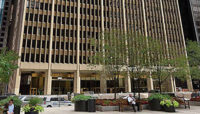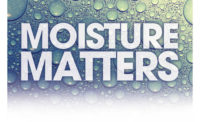Getting a commercial office building ready for re-occupancy post-COVID-19 is a challenge. Adding in the risk of Legionella bacteria compounds the potential for a compound disaster.
Legionella, a bacterium that causes a pneumonia-like illness called Legionnaires’ disease, grows in the still waters of cooling towers, hot water heaters, fountains, faucets, and showers when plumbing systems are left stagnant or underheated. Commercial buildings that shut down their HVAC systems to reduce energy bills and/or failed to run the water while unoccupied are ripe for bacteria growth.
Both COVID-19 and Legionella are transmitted through aspiration. COVID-19 is aspirated via an exchange of air between humans, while Legionella is aspirated via water. Without traditional safeguards, including continuous movement and cleansing of water and maintaining 120°-140°F building water temperatures, Legionella can spread to water droplets small enough to breathe in and infect occupants.
Before re-opening a facility, building owners and managers must consider each and every faucet, hose bib, tenant humidifier, fountain, and shower head as a possible Legionella infection source. Here are six tips to making the return to work a safe one for all occupants.
1. Drain fixtures completely and refill — Bathroom faucets, kitchen sinks and showers will carry the biggest potential for infection spread. Make sure the plumbing system is flushed completely with new cold water to replenish the residual chlorine in the system. Once the systems have been flushed, temporarily increase the temperature of the hot water heaters to 140°. Then run each fixture again with full hot water for 5 minutes to kill any remaining bacteria. Hit every bathroom and kitchen faucet, the showers in the building’s gym, swimming pool, hot tub, and spa as well as the lobby fountains. Building engineering and maintenance personnel should wear a mask and gloves when draining and refilling to protect themselves from any exposure to pathogens.
2. Now, test — Once fixtures have been flushed, and hot water heaters are up and running for 48 hours or more, spot test for Legionella across faucet types in multiple locations. Legionella testing kits will provide results in just two hours. Retain the results for your records to minimize your liability. In the event that an occupant gets sick and there’s a claim against your property, you’ll need the records to defend the claim.
3. Do it in enough time — Running faucets a few hours before tenants return isn’t going to cut it. Do it early enough to complete the entire building multiple days, if not a week — at the very least, 48 hours — before occupants return. This means closely following the governor’s order in your state and preparing accordingly.
4. Extend timing of automatic faucets — Touchless faucets are ideal for reducing the spread of bacteria on handles, but they only run water for five seconds, not the 20 required to prevent the spread of infection. Furthermore, running water for five or even 10 seconds (assuming the occupant engages the sensor twice!) isn’t enough to demand hot water, which is also critical to reducing infection. When possible, reset automatic faucets to run for longer and reach a higher water temperature earlier.
5. Eliminate point of use aerators — There’s a reason aerators aren’t used in hospitals, as they are known to retain bacteria at the spout. By definition, aerators pull air in and mix it with water to reduce water use while still delivering the same feel. When turned on, an aerator will spray whatever is in its point-of-use spout, including bacteria, into the air and onto the sink or faucet users. Instead, select laminar flow faucets with a plain spout that dry completely after each use.
6. Move forward with precaution. Building operators and maintenance personnel will want to establish protocol instituting these best practices as regular maintenance moving forward. Include daily faucet runs and monthly Legionella testing to keep your facility free of bad bacteria. Consider increasing these strategies when facilities are running at partial load with reduced occupants. Make sure hot water heater temperatures are set to manufacturer recommended values and that staff is outfitted with masks and gloves when running faucets and testing.
Preventing COVID-19 and Legionella in the Workplace
Early symptoms of COVID-19 and Legionnaires’ disease are similar, and because infection in both cases comes from aerosolization, building occupants that come down with a cough or fever may mistakenly assume they’ve contracted one or the other. Misdiagnosis could lead to increased liability for building owners and operators.
While these best practices will ensure that building managers have done everything they can to prevent building aerosolization of pathogens, they aren’t a cure all for infection prevention. Remind occupants and tenants to continue washing their hands regularly, wearing masks, and minimizing surface contact as much as possible.
Filter it Right: HEPA, MERV, UV, and Ionization Systems
Unlike COVID-19, Legionella bacteria is well-known and understood. Prevention and mitigation is possible. Employing effective filtration is the first step. Consider the following filters and their advantages and disadvantages.
- MERV – Most filtration systems are specified and identified today using the MERV designation. The higher the MERV value, the more pathogens it filters. Prior to the sustainable building movement, and the introduction of LEED, most commercial building filtration was limited to MERV 8. Newer buildings are typically specified with MERV-13 filtration systems, capturing up to 75% of all 0.03- to 0.1-micron particles. Filtration with less than a MERV-13 rating should not be expected to capture viruses or bacteria. MERV-17 (HEPA) and MERV-18 (ULPA) ratings are considered the highest and are typically reserved for health care, clean room, manufacturing, pharmaceutical, and other clinical environments.
-
UV Systems – UV technology is 100% effective in killing viruses and bacteria in the airstream. In order to do so, though, the air must go through the UV system. Some hospitals employ UV systems in patient rooms because they’re so effective at taking in all the air from a single room and then releasing it after it has killed off anything harmful. UV systems require a special air-handling unit (AHU) system to function, which means consideration for these systems is only possible during initial building design or when renovating HVAC systems. Building owners/operators are now considering employing UV technology in lobby areas, where occupants walk through to have their temperature taken. While this sounds like a promising idea, the UV rays will only remove the bad agents on the occupant’s clothes, bags, etc., which is not significant compared to the ability of an a-symptomatic carrier to spread bacteria or a virus when working directly with someone in the case of COVID-19, or while taking a hot shower in infected water, in the case of Legionella.
-
Ionization Systems – By releasing positively and negatively charged ions into an HVAC systems’ airstream, ions interact with particles floating in air-conditioned spaces, killing pathogens by robbing them of their hydrogen atoms. Particles in the air will combine with particles of the opposite charge. These larger particles fall out of suspension in the air on to the ground and can be vacuumed up. Larger particles are much easier for the filtration systems to capture. Some manufacturers claim performance as effective as MERV 16 when combined with ionization technology.
- HEPA – It is widely thought that HEPA filtration is the most effective solution for the removal of pathogens from HVAC systems; however, HEPA filtration is usually not a practical or even economically feasible for commercial office buildings. Requiring significant fan power and space, HEPA filtration systems are typically reserved for health care environments.







